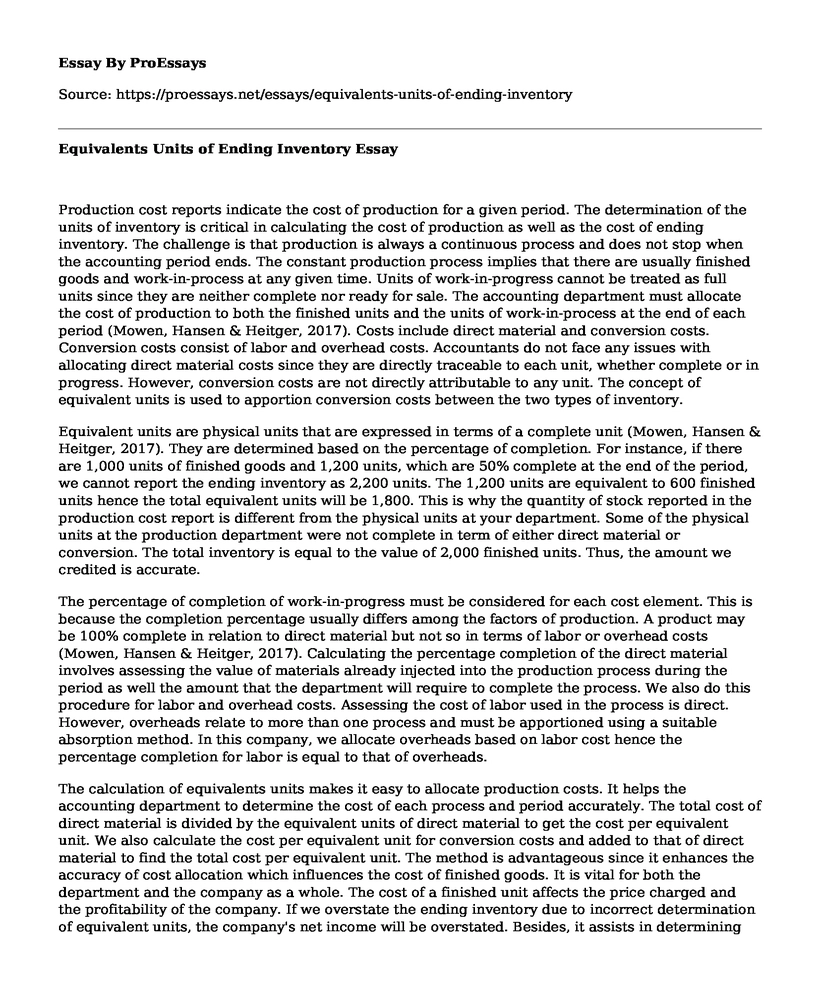Production cost reports indicate the cost of production for a given period. The determination of the units of inventory is critical in calculating the cost of production as well as the cost of ending inventory. The challenge is that production is always a continuous process and does not stop when the accounting period ends. The constant production process implies that there are usually finished goods and work-in-process at any given time. Units of work-in-progress cannot be treated as full units since they are neither complete nor ready for sale. The accounting department must allocate the cost of production to both the finished units and the units of work-in-process at the end of each period (Mowen, Hansen & Heitger, 2017). Costs include direct material and conversion costs. Conversion costs consist of labor and overhead costs. Accountants do not face any issues with allocating direct material costs since they are directly traceable to each unit, whether complete or in progress. However, conversion costs are not directly attributable to any unit. The concept of equivalent units is used to apportion conversion costs between the two types of inventory.
Equivalent units are physical units that are expressed in terms of a complete unit (Mowen, Hansen & Heitger, 2017). They are determined based on the percentage of completion. For instance, if there are 1,000 units of finished goods and 1,200 units, which are 50% complete at the end of the period, we cannot report the ending inventory as 2,200 units. The 1,200 units are equivalent to 600 finished units hence the total equivalent units will be 1,800. This is why the quantity of stock reported in the production cost report is different from the physical units at your department. Some of the physical units at the production department were not complete in term of either direct material or conversion. The total inventory is equal to the value of 2,000 finished units. Thus, the amount we credited is accurate.
The percentage of completion of work-in-progress must be considered for each cost element. This is because the completion percentage usually differs among the factors of production. A product may be 100% complete in relation to direct material but not so in terms of labor or overhead costs (Mowen, Hansen & Heitger, 2017). Calculating the percentage completion of the direct material involves assessing the value of materials already injected into the production process during the period as well the amount that the department will require to complete the process. We also do this procedure for labor and overhead costs. Assessing the cost of labor used in the process is direct. However, overheads relate to more than one process and must be apportioned using a suitable absorption method. In this company, we allocate overheads based on labor cost hence the percentage completion for labor is equal to that of overheads.
The calculation of equivalents units makes it easy to allocate production costs. It helps the accounting department to determine the cost of each process and period accurately. The total cost of direct material is divided by the equivalent units of direct material to get the cost per equivalent unit. We also calculate the cost per equivalent unit for conversion costs and added to that of direct material to find the total cost per equivalent unit. The method is advantageous since it enhances the accuracy of cost allocation which influences the cost of finished goods. It is vital for both the department and the company as a whole. The cost of a finished unit affects the price charged and the profitability of the company. If we overstate the ending inventory due to incorrect determination of equivalent units, the company's net income will be overstated. Besides, it assists in determining the efficiency and performance of the production department as well as each process. An overstatement of equivalent units implies that a higher amount of overheads will be allocated to your department (Mowen, Hansen & Heitger, 2017). This may indicate that your department is not efficient contrary to the real picture. It also helps your department to determine the amount of work it requires in the next accounting period or in the next process.
References
Mowen, M., Hansen, D., & Heitger, D. (2017). Managerial Accounting: The Cornerstone of
Business Decision-Making. New York: Cengage Learning.
Cite this page
Equivalents Units of Ending Inventory. (2022, Apr 04). Retrieved from https://proessays.net/essays/equivalents-units-of-ending-inventory
If you are the original author of this essay and no longer wish to have it published on the ProEssays website, please click below to request its removal:
- Profile of Sohar's Company and the HR Strategies They Use
- Reasons People Resist Organizational Change Paper Example
- Project Management Annotated Bibliography
- The core skill here is Time Management.
- Managing Diversity in a Workplace - Essay Sample
- Essay Sample on Mentoring Journey
- Essay Example on Can Authoritarian Leadership Work in Modern America?







